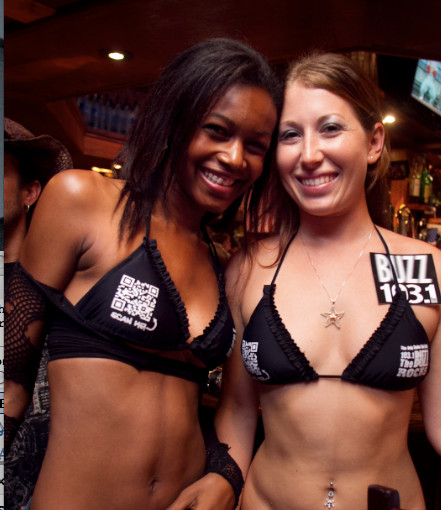How radio and broadcast sites can use QR codes
QR (Quick Read) codes are the square bar code images, now showing up on everything from posters to T-shirts, which cell phones scan using their cameras. The phone reads the code and pops up the promotional web page or text massage. Since this technology requires something printed to scan, how can broadcast and radio use QR codes ?
Summary
Part one of LMI's 2011 round-up of QR code usage looks at two radio and television station groups who are figuring it out, CBS Radio in West Palm Beach and Entravision, a Hispanic language radio and televisions group. Their experiences point to three main uses:
a. Creating fun and edgy brands. CBS radio in West Palm Beach is incorporating QR codes into a variety of promotions. Most of these are "for show" but all contribute towards building the "text club" for promotional events. And since events are sponsorable, this lays the ground work for larger sponsorships, and for selling the same QR-to-text opt-in opportunities to event sponsors in the future.
b. Additional, faster way for people in transit to access promotions and information. Entravision, a Hispanic network of radio and broadcast sites, on the otherhand, sees QR codes as an intrinsic add-on for its hyper-mobilized market, whether for decal-to-web promotions of its Spanish language directory or for posters that promoting contests at sponsor locations.
c. Laying groundwork to create larger campaigns with deeper hyper-local engagement. These are not game changing results. The highest response - and most monetizable promotions - are those that involve contests and text-backs, which can be incorporated - and monetized as event sponsorships and on-location promotions. However, we see these experimental initiatives today being monetized more heavily in 2012.
The results from these early initiatives are not mature. Only 6% of the cell phone market has scanned a code, which requires both a smart phone and an app download, and, therefore, a compelling reason! However, the kitch and "edge" factor, is clear and QR codes are increasing response rates when users are given a choice of typing a URL or texting versus scanning in some cases. We've seen results elsewhere that QR code scanning accounted for 6% of total responses for a promotion; and up to 50% at a technology convention where the demographic is ideal (tech savvy, 60% male, 53% under 35, 35% household income more than $100,000). The good news is that QR codes are free to create and place on anything that can be printed and there is no need for required reading at the local level, since you can also include the URL or short code.
Case study 1
Media: CBS Radio, five stations with different genres
Market: West Palm Beach
Key Executive: Karyn Barone, Director of marketing
Summary: The marketing director for CBS radio in Palm Beach, Karyn Barone, uses QR Codes in promotions to enhance promotional cache and build its text-club. Down the road, she anticipates these promotional uses will be packaged and sold to event sponsors. Among the variety of uses for QR Codes by the five stations:
*Business cards and email signatures of sales people
A variety of broadcast companies now include QR codes on business cards and e-mail monikers, which allows contacts to scan cards and email monikers directly into their phone address book, and brands sales teams as digitally savvy.
Sales people at CBS all have QR codes on their cards:
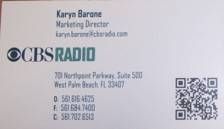
* Wraps on promotional vehicles.
CBS radio wrapped its promotional vehicles with the logos - and QR codes of the five stations in August, 2011. The codes include a call-to-action, asking passersby to scan “join our text club.” After they scan and opt-in, users receive a texts for station promotions. Each station has its own code.
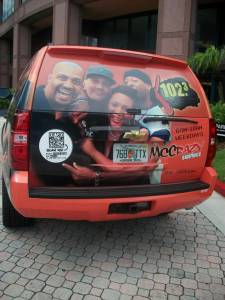
In the first two weeks since the cars were wrapped, traffic from the QR codes was “not a whole heck of a lot but it’s really cool.” That is, if people don’t scan, “they remember they saw me truck it’s the kitchy wow factor. “
*T-shirts and ....,well, bikinis
The promotional team includes women in bikini’s printed with the station's QR code.
“The girls that we have are very outgoing. When we first had the idea, I thought this maybe this is too edgy; let's see if they want to do it.” But the street team “loved the idea.” This is a rock station that also runs a street corner “Strip Trivia” contest, in which one of the women strips to a bikini on the side of the road.

“I don’t think we get a lot of people who actually scan the girls, but, again, it’s the “wow factor.”
Other scannable clothing includes T-shirts and so on. Resources for local media insterested in including QR codes on chotskies include:
QRstuff.com - A preferred LMI member vendor for qrcodes with analytics, and basic schwag from t-shirts to coffee mugs.
QRLicious - Custom codes that include images and logos
HolmesRubberStamps - Create a rubber stamp with your code, (give it to taggers in your neighborhood?)
qrchocolates.com - Not sure if you can really scan these chocolates
We don't know where the bikinis came from. Here's another sweat-shirt from CBS:
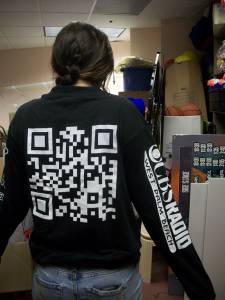
*Posters at events and VIP badges at concerts
The most actually scans come from “scan to win” contests on posters hung at events the stations sponsor and which also generate a "text back" opt-in to the text club.
The back of the VIP badges for concerts - a mainstay for enter-to-win contests - includes a scannable code for a bigger prize.
Since these are text-back programs, the short code is also incuded. Responses are split between the two, ie typing in a short codes or scanning - but the scans have increased opt-ins.
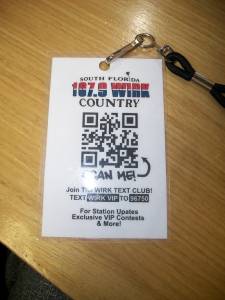
Barone says the idea for putting QR Codes on VIP passes came up “when I went to a Food and Wine Festival Fort Lauderdale, and the VIP area was sponsored by JM Lexus, who had four or five cars on display. You had a chance to win a lease if you had a VP badge, which had a QR code unique to each person that told you if you were the person who won. Every single person scanned their badge and very person got their email and information captured. Watching 200 or 300 people scanning" badges was a powerful lesson.

"What a great way to draw people into your booth. I tell all of the vendors to use the QR codes."
* On the road map: selling these inhouse programs to sponsors
Marone anticipates that QR codes on posters, badges and clothing will eventually part of event sponsorships. The end goal “is that I can use it with sponsors, sponsor those badges and posters and use them to monetize our events and let them put their own qr codes on it. That’s our plan.”
Case study 2:
Media: Entravision in 48 Spanish-language radio and 53 Spanish language television stations in 11 U.S. markets
Key initiative: QR code decals promoting Busca online directory, and contests to built text-opt-ins
Key Executive: Mary Anne Collins, Mobile Operations Director
Not only do Hispanics over-index in mobile usage of all kinds, but also about 45% of the Hispanic population, compared to 35% of U.S. population as of August, 2011, has a smart phone, "so this works on many different levels." Entravision already is heavily involved in text-based marketing, so QR codes are a logical next step in a marketplace that shows rapid adoption of all things mobile.
Here are some quick facts from a study of mobile usage by Hispanics (18+, who have purchased retail, technology or Auto in the past year) compiled by Scarborough:
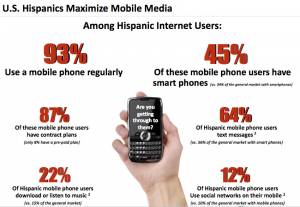
Entravision's first two major initiatives supported by QR Codes are its business directory and poster campaigns for text-back contests.
A Spanish language directory, Busca, resides on all of the local radio stations, and is branded with the name of the city or state, for example, on www.wventv.com you will find buscaorlando.com
To support the SEO and online directory product, the local team in Denver created window decals with QR codes scanning back to the directory, and gave them to 60 retailers who advertise in the directory. Since Busca is promoted on the television station's Spanish language programming, this creates a direct visual tie-in for people who have seen the on-air or online promotions, when they get to the store. Here's how the decals look:

Since distributing the first 60 decals, traffic to the directory - the only way the stations track these codes - is up by a small margin and the total mobile traffic continues to grow.
Text-back contests
Entravision has also started putting text-back short codes - and QR codes - around events and at contest sponsor locations. Television and radio drives traffic to the sponsors physical location where they can scan or textback an enter-to-win. Response rates are increasingly split between the two kinds of functionality.
Below is a poster allowing users to win tickets to super-popular Mexico vs. New Zealand Soccer Game. The QR Code goes directly to the entry page, the regular short codes text message do not.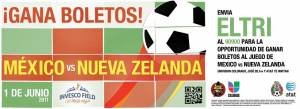
Some posters images are also placed on web sites with codes and at point of sale at retail sponsors, so on-air campaigns can drive people to sponsors' locations to register via QR code or text-back. Here is another poster promoting free tickets to WaterWorks, a family park:
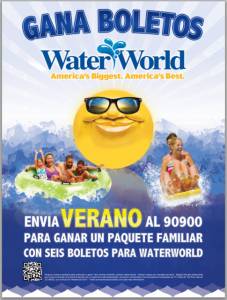
"We have proven success with SMS (without QR codes) and that mobile is the most basic thing (people use). In 2003 people didn't understand how to send a text message. With QR codes, people think, yeah, its cool. Just curious, and if I got something, that would be great." Marone sees increasing adoption in the Hispanic market means that code usage will become more standard.
And also, Late Night with Jimmy Fallon
The only purely onair QR code use we ran across that is worth mentioning is Late Night with Jimmy Fallon. Fallon simply held up a poster with a QR code, after introducing the band, OddFuture, who was performing live. The camera zoomed in on the code, which linked to the OddFuture website and a YouTube video embedded there. By March, 2011 the site had been accessed 14,001 times, 99% of those accesses coming from the QR code - still a pittance for a national show. Fallon has followed up with the occasional QR Code that links to extra online rich media, including a "secret video" after an onair concert with several megastars:
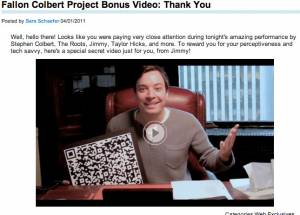
Our take
Besides "wow" factor promotions with QR Codes on cars, bikinis and so on, the most monetizeable usages seem to be in conjunction with contests, in which the scanner gets something highly desirable - such as an offer or enter to win. This helps new users jump the key obstacle - downloading an app and learning something new. We see these kinds of in-house campaigns will be highly marketable in the future for event sponsors and large advertisers who want something unique, that has deep local engagement and positions the brand. Chevy Volt is one company, for example, that has worked event sponsorships placing QR codes on its cutting edge green cars and even giving one away, though at a national, technology conference where 50% of users, compared to 6% normally, chose to scan instead of type.
We think scannable decals promoting directories at merchant locations are also a good idea - and only a first step. One improvement would be to create an overlay one the directory home page to collects opt-ins - perhaps in return for an enter-to-win. One downside of decals is that codes cannot change their URL (unless you invest in this kind of dynamic solution), however the content on the mobilize landing page can be changed from the other end.
Another usage that gives scanners something - and collects data - are scan to mobile coupon programs, which are under-development elsewhere. There is no reason why broadcast sites cannot develop and market these kinds of programs.
Finally, we like the idea of on-air campaigns driving consumers to brick and mortar stores to enter-to-win, collect a discount - and opt-in - via in-store posters, a usage we've seen by Shoe Station. Get to know the SMS providers in your market, and you will find the retail and pizza outlets that are heavily using text-base marketing and need promotions. While this technology is new, it's also on the rise and simple to use in conjunction with other kinds of marketing.
Many thanks to Mary Ann Collins, Director of Mobile Operations at Entravision and to Karyn Barone, Director of Marketing at CBS Radio for sharing these case studies with us, and to Paul Tappscott at Centro for sharing his expertise on code usage.

The author, Alisa Cromer is publisher of a variety of online media, including LocalMediaInsider and MediaExecsTech, developed while on a fellowship with the Reynolds Journalism Institute and which has evolved into a leading marketing company for media technology start-ups. In 2017 she founded Worldstir.com, an online magazine, to showcases perspectives from around the world on new topic each month, translated from and to the top five languages in the world.

